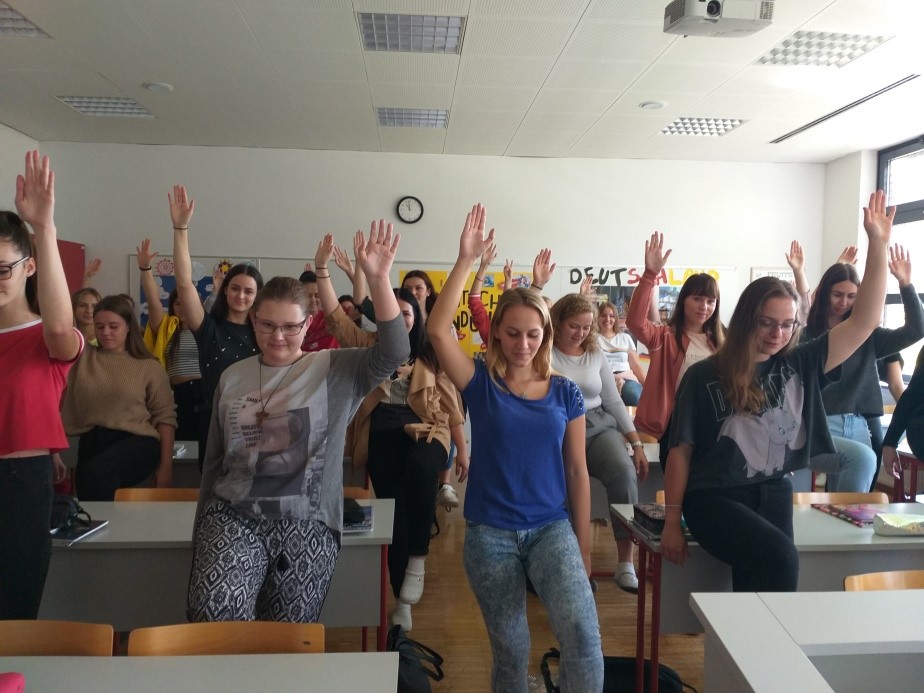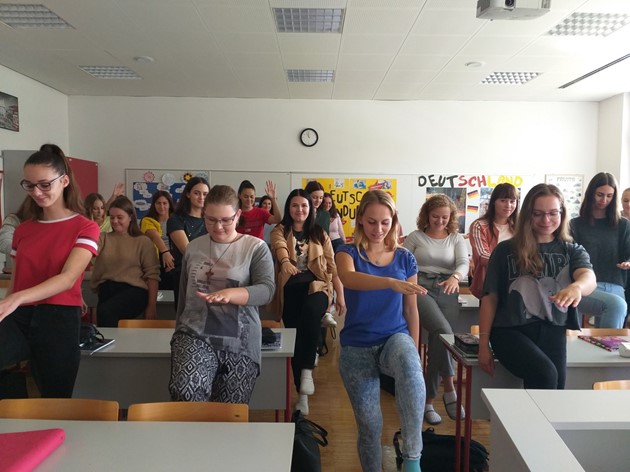Introducing Brain Gym Into Language Classes
Maja-Barbara Kokot has been working as a teacher of English at a vocational school, Secondary School for Nurses Celje in Slovenia for 15 years. She teaches in the programmes of health care and cosmetology (students aged 15-19). For the last 14 years she has been a part of the team preparing the annual national competition in the English language called Poliglot. It is a national competition for vocational schools in Slovenia.
Just another teaching approach?
When my colleague, a teacher of German, introduced Brain Gym to the rest of us, foreign language teachers at our school, I must admit my first reaction was not another modern method of teaching. I was not particularly interested until the fourth-grade students from her class asked her to do the five-minute activity before their final exam called Vocational Matura.
My colleague Urška Zakošek had taken part in a teacher training course in Vienna, more precisely at the school Handelsakademie, where Brain Gym was systematically integrated into classes and even oxygen meters installed into classrooms. Later on she qualified as an instructor at the Bundesgymnasium, which represents the Austrian centre of the »Vital for Brain / Simply Strong« movement (https://www.simplystrong.at/).
Brain Gym is really simple
Educational Kinesthetics or Brain Gym encompasses motion which does not only activate parts of the brain (the left or right hemisphere, the brain stem or brain lobes, the limbic system or cerebral cortex), but the whole brain. These exercises strengthen our perception, visual and spatial orientation, structuring, logical thinking and verbal skills. It was introduced in the seventies by the educational therapist Paul E. Dennison, whose research revealed that lack of coordination between the left and the right hemisphere resulted in learning difficulties. The supporters of this movement-based approach claim the simple exercises have an impact on the learning process as they help to change the dominance of one brain side into reciprocal balanced functioning of both sides.
From the point of view of Edu-Kinesthetics brain is divided into three dimensions, namely lateral, focal and central. Simplifying a bit we can say the lateral dimension (left and right hemisphere) is key to reading, writing, speaking, listening, cognitive functions and movement. If the midline cannot be crossed, one can experience disorders such as dyslexia. The focal dimension (front and back part) is crucial for understanding and verbal communication. If not developed properly one cannot express themselves fluently, has difficulty understanding or suffers from attention disorders or hyperactivity. The central dimension (cerebrum and midbrain) provides balance between ratio and emotions. Difficulties concerning this dimension include irrational fear from the unknown, which in the learning process, means students are reluctant to accept information or accept them with a negative connotation or in addition are unable to express emotions.
Specific Brain Gym exercises are effective for specific obstacles; exercises for the lateral dimension have the function of encouraging and motivating, those for the focal dimension relax whereas the exercises for the central dimension have a calming effect. The exercises are an efficient tool to improve physical coordination, memory skills, organisational abilities, attention disorders, mathematical skills and those of reading, writing and listening. They are a healthy alternative to relieve tension, reduce stress, to motivate and deal with learning difficulties.
I will only present one of the exercises I use in my English lessons. The exercise is called ‘Cross Crawl’. If interested in more of the exercises, I recommend Brain Gym Teacher's Edition by Dennison and Dennison, which details the 26 Brain Gym activities. It offers a complete guide describing individual exercises in detail, their execution, their influence on the brain and consequently their impact on learning abilities.
To do ‘Cross Crawl’ you stand and “march”, alternately touching one hand or elbow to the opposite knee. Make sure to raise your knee as high as possible and twist your body as you ‘Cross Crawl’. (Picture 1 and Picture 2). This exercise (L. Kalish, 2016):”
- stabilizes your walking gait coordination – builds core strength,
- energizes your body and calms your mind – releases tension and stress,
- improves your eye teaming skills – essential for focus, reading, and writing,
- enhances whole brain thinking – your left and right hemispheres work together,
- develops proprioception – your spatial and kinaesthetic awareness.”


Water
Dennison (2007) underlines the importance of regular water drinking in small quantities. Water enables the conductivity of electrical currents between the brain and the senses which is the basis of all electrical and chemical process in the brain and the central nervous system. According to him water is essential for relieving stress and mental fatigue as well as remembering and recalling information. He observed that after having quenched their thirst his students were more attentive and lively. My students like the idea of being allowed to drink water during classes very much, especially due to the fact our school rules do not allow to bring food and drink into classrooms.
Conclusion
Although there are authors (Hyatt, 2007) who doubt Brain Gym is as effective as its promotors claim, this technique to facilitate learning is widespread and popular. My personal experience while introducing it into classes is really positive. I cannot provide data based on research, I rely simply on the reactions and comments I get from the students. Despite the fact they are teenagers, who in general are not keen on school sport activities, they like doing these exercises and after doing them, their mood changes and they are better motivated for learning. Teachers can introduce these movements into classes without the fear of lacking time for the subject matter as they take from five to ten minutes. They can serve as a warm-up activity, a mini break during harder tasks, round-ups or as a way to reduce stress before exams and test papers.
However, Brain Gym is not only limited to the school environment and to learning a specific subject matter. It can also be carried out by adults as it integrates individual’s psychological, physical and emotional component and thus facilitates the way to reach goals and perform various tasks. Personally I consider it as a way to become more self-aware, to be present in the moment “here and now”, which in today’s hectic world is quite hard.
References
Dennison, P. E. in Dennison, G. E. (2007). Telovadba za možgane. Revidirana izdaja za učitelje. Ljubljana: Rokus Klett, d.o.o.
Kalish, L. (2016) 10 Benefits of Cross Crawl – Brain Hemisphere Synching Exercise. Available at: https://move-with-me.com/author/leah-kalish/page/3/
Hyatt, K.J. (2007). Building Stronger Brains or Wishful Thinking?. Remedial and Special Education, 28(2), 117- 124. Available at: https://www.researchgate.net/publication/249835283_Brain_GymR_Building_Stronger_Brains_or_Wishful_Thinking
Please check the Creative Methodology for the Classroom course at Pilgrims website.
Please check the How to Motivate Your Students course at Pilgrims website.
Introducing Brain Gym Into Language Classes
Maja-Barbara Kokot, Slovenia